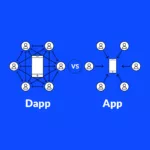Decentralised Finance vs. Traditional Finance
The debate between DeFi vs. TradFi is really beginning to heat up. In this article, we’ll explore the differences between the two, as well as the benefits and drawbacks of each. We’ll also answer the question of which is better. But for now, what is the difference between decentralised and traditional finance?
Decentralised finance (DeFi) and traditional finance (TradFi) differ hugely. Primarily, it is the decentralisation that separates the two. Decentralised finance operates using blockchain technology. This removes the need for third-party intermediaries used by traditional financial institutions.
What is DeFi?
Decentralised finance (DeFi) is an emerging technology. It is an umbrella term for peer-to-peer financial services built on blockchains. Decentralised finance is very similar to centralised finance (CeFi). As the name suggests, DeFi offers the same services as CeFi, but challenges the rules and limitations applied to centralised institutions, such as banks. Third-party intermediaries and centralised bodies are removed from the equation. This enables greater privacy and security. Decentralised finance gives individuals back control of their own money and assets.
With DeFi, users can earn interest, borrow, trade, lend and more. Most traditional financial services are catered for within DeFi. Decentralised finance is often faster and more affordable. It also has increased anonymity compared to the traditional alternative. There is also an incredible range of options available within DeFi:
- Decentralised exchanges (DEX) – DEXes are built using smart contracts. Individuals can utilise a DEX to swap tokens and trade cryptocurrencies without intermediaries getting involved.
- Automated Market Maker (AMM) – AMM platforms are similar to DEXes, but use a mathematical formula to price assets automatically.
- Staking – Users are rewarded for locking their digital assets into a proof-of-stake (PoS) network. Staking provides security to the network in question while helping to validate the transactions on a blockchain.
- Yield farming – Yield farming involves making returns (sometimes significant) on a cryptocurrency investment. Individuals deposit their cryptocurrencies into a liquidity pool and earn rewards for doing so.
How Does DeFi Work?
DeFi utilises blockchain technology – namely distributed ledgers – much like those employed by cryptocurrencies and the companies that designed them. Decentralised applications (dApps) are used to handle transactions and effectively help to run the blockchain.
Transactions on a blockchain are recorded in blocks. They are then verified by users on the blockchain network. Once a group of verifiers – sometimes referred to as validators – agree on a transaction, the block is closed and encrypted. The blocks are ‘chained’ together, which is where the word ‘blockchain’ comes from. The blocks are linked together through information from the following block. Information within a block cannot be changed without also altering the other blocks in the chain. All this means that blockchain data is unalterable, secure and decentralised.
Advantages of DeFi
Decentralised finance is incredibly important. The decentralisation of finance, in theory, leads to a fairer system that is more advantageous for the individual, rather than the institution. As there are no centralised authorities governing a particular network, nobody can halt payments or block transactions. Because there is nobody “in charge” of a blockchain, individuals cannot be denied access to DeFi protocols.
Disadvantages of DeFi
What is TradFi?
Traditional finance (TradFi) refers to traditional banks – commercial, retail and investment – and financial technology (FinTech) companies. These are effectively the mainstream institutions that have historically governed how people store, spend and save their money.
The TradFi space is a characteristically centralised one. Retail investors are oftentimes excluded from lots of the financial services that might be available to other investors. TradFi companies are at the mercy of governmental rules and regulations, including Know Your Customer (KYC) checks and Anti-Money Laundering (AML) laws.
Advantages of TradFi
Although TradFi’s centralisation is a concept many are looking to move away from, there are some benefits to the traditional finance space:
Disadvantages of TradFi
There are several drawbacks to the traditional financial model:
DeFi vs. TradFi: The Similarities
When comparing DeFi and TradFi, there are some obvious similarities. Firstly, neither is perfect in its current form. Both decentralised finance and traditional finance are plagued by fraud, financial abuse, operational failures and the like. TradFi, as a concept, has been around for far longer than DeFi, and yet these issues are still prevalent. DeFi, for all its potential, still suffers from similar issues.
There are arguably four main problem areas that both DeFi and TradFi share:
- Consumer and investor protection
- Market integrity
- Prevention of illegal activity
- Stability
Traditional finance and decentralised finance attempt to deal with these issues in their own way. For example, TradFi implements government-backed KYC checks to help protect consumers. DeFi instead prefers to remove middlemen for the same reason. Although dissimilar in their methods, both financial operations are linked in the challenges that they face.
DeFi vs. TradFi: The Differences
The key difference between traditional and decentralised finance is the centralisation of the former. In decentralised finance, individuals hold their money, whereas, in traditional finance, it is held by companies. With this in mind, individuals, therefore, have greater control of their money within DeFi. On the other hand, TradFi requires an element of trust on the behalf of the individual. It’s impossible to guarantee that TradFi companies won’t mismanage their customer’s money.
Additionally, manual processes within TradFi can cause payments to take days to complete. Transfers of funds within DeFi often happen in minutes. Admittedly, this isn’t the case for all elements of TradFi; sending money to a friend, for example, can often be completed in seconds. However, DeFi utilises dApps and automated code, making processes – in general – much quicker than the traditional alternative.
The pseudonymity of DeFi is one of its greatest assets compared to TradFi. Anybody can create and start using accounts within DeFi in a matter of minutes. In the traditional finance space, not everybody is granted access to bank accounts or financial services. This potential lack of access to financial services could be detrimental to an individual looking for employment, housing, or anything in between.
Which is Better: Traditional Finance or Decentralised Finance?
The comparison between traditional finance and decentralised finance is an interesting one. Taking financial decisions out of the hands of corporations and putting them into the hands of the consumer is an admiral long-term goal. Removing companies’ ability to dictate an individual’s financial decisions is important. In the debate between DeFi vs. TradFi, therefore, it’s clear that the former is the best, in theory.
However, at the time of writing, TradFi and DeFi are two very separate entities. Following the crypto market crash at the end of 2021 and moving into 2022, the market capitalisation of crypto-assets fell from almost $3 billion to well under $1 billion. This huge crash seemingly had very little impact on TradFi. This suggests that decentralised finance has not, as yet, had the desired effect of moving people away from its traditional counterpart. For now, TradFi seemingly holds the upper hand. However, the concepts and ideas behind DeFi suggest that it will prevail in the long-run.




